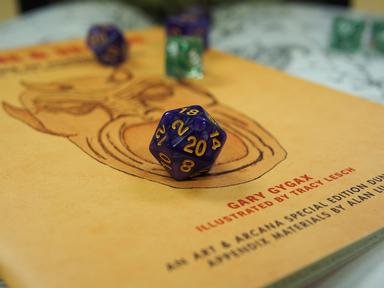Quiz Answer Key and Fun Facts
1. Please note that there were several editions of the Dungeons & Dragons Basic Rules Set, all of which are for characters from levels 1-3. All the questions in this quiz specifically refer to the 1983 edition, and not to the earlier editions by Eric Holmes (1977) and Tom Moldvay (1981).
The Players Manual of the Dungeons & Dragons Basic Set begins with a simple solo adventure with a pre-generated character designed to teach new players elementary game mechanics needed to play the game. During the first part of the adventure, your character meets a friendly cleric named Aleena, who gives your character help and advice. What happens to her soon afterwards?
2. The second part of the solo adventure features encounters with several different kinds of hostile creatures. Based on the hit rolls needed to strike them and their respective hit points, which of the monsters in the encounter is likely to be the most difficult to defeat?
3. In the Basic rules of Dungeons & Dragons, which activity earns more experience points?
4. One of the special abilities of the cleric class is Turning Undead, that is, compelling undead monsters to flee from the cleric's presence. When a cleric advances to level 2, they gain the ability to Turn what creature that level 1 clerics cannot?
5. In the Dungeons & Dragons Basic rules, players have the option of choosing from human or "demi-human" characters, that is, humanoid races with special abilities that humans do not have. Which of the following is NOT one of the options for demi-human player characters in these rules?
6. Magic-users at low levels are very limited in the number of spells they can memorize each day. For example, a third-level magic-user can only memorize two first-level spells and one second-level spell, and may not memorize any higher level spells. If a third-level magic-user were to find a magic scroll containing a spell higher than second-level, would they still be able to use it?
7. Members of the thief class have a number of potentially very useful special abilities, although at low levels, these are for the most part not very well developed. Of the following special abilities, which would a thief of levels 1-3 be most likely to succeed at on a given attempt, according to the Basic rules?
8. Which of the following best describes the character alignment options in the Dungeons & Dragons Basic rules?
9. The Dungeon Master's Rulebook of the Basic Set describes a number of magic items that player characters may find in their adventures. Some of these are permanent, that is, they can be used any number of times, while others have a limited number of uses (sometimes only one) before they become non-magical. Of the following magic items described in the Rulebook, which one is a permanent item?
10. The Dungeon Master's Rulebook of the Basic Set outlines an introductory group adventure that novice dungeon masters may use to learn how to run a game for low-level players. The adventure involves exploring the ruins of an old castle that contains a number of hostile creatures. In the first level of the castle, which of the following creatures that the player characters may encounter are likely to be the most dangerous, considering their abilities and game statistics?
Source: Author
agentofchaos
This quiz was reviewed by FunTrivia editor
WesleyCrusher before going online.
Any errors found in FunTrivia content are routinely corrected through our feedback system.
